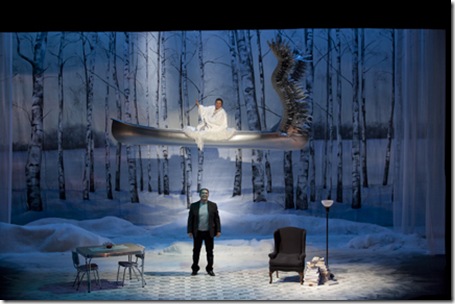For the Pleasure of Seeing her Again : the production pulls through on the strength of the play.
Photo: Festival Magnetic North.
Seeing this play after so many years I realized just what a beautiful and important plays it is in relation to the body of Tremblay’s work. It is not only about his mother, whom he conjures up in this part autobiography, part auto fictional memory of a son trying to rectify a certain feeling of guilt. It is also a manifesto of Tremblay’s theatre poetics, a document that gives us, in an oblique way, all the strategies that Tremblay uses to construct his plays.
Through the voice of this woman who barely has any education, who spends her time cleaning and baking and caring for neighbours and family, we learn all about his plays. She is the voice of the “people” who have an essential role in Tremblay’s theatrical world, and who have always been the focus of his work. In the prologue he makes a collage of references to all the great works of French theatre, even bringing Shakespeare and Lorca into the mix.
Then he steps into the image of his Mother’s house as Pam Johnson’s beautiful set lights up. The mother starts her monologue which is addressed to her son sitting in an armchair. This is her play and she carries it the entire two hours, a most difficult feat for any actor – especially without intermission.
For the moment I’ll focus on the written text where we hear all his theatre emerging through the mother’s non-stop chatter: the importance of certain actresses in his work; the confusion between characters and actors which the mother tries to understand but which sends us back to the way that Tremblay always worked with his own parallel family of actors for his own show; the way his theatre is built upon a network of complex family relations. The way his mother complains about the aunt and the uncle reminds us that Tremblay both hates and loves his characters, just as his mother irritates him with her stories and her worrying. But she is always an endearing figure who has a central place in his writing and in his life.
The mother brings up the idea of the confessional monologue that Tremblay uses in all his works. It brings up special memories of Les Belles Soeurs as each woman steps out of the crowded kitchen into that famous spotlight to tell the audience her worries, her fears, and the terrible secrets that are ruining her life. And there is the famous Duchess of Langeais monologue, when this legendary transvestite takes us into the near tragic underworld of those “strange friends” whom the mother is starting to notice.
There is, of course, much more. But the main thing is that this theatrical performance speaks about Tremblay’s theatre just as it examines his relationship with his mother. As such it could be compared to other manifestos such as Moliere’s Impromptu de Versailles, Giraudoux’s Impromptu de Paris, and one of Tremblay’s other works, L’Impromptu d’Outremont, which is also a reflexion on theatrical style and bourgeois culture in Montreal. Even the ending is a grand gesture to French theatre with its deus ex machina, a heightened moment of classical theatricality used by Molière, who always celebrated King Louis XIV at the end of each of his Opéra Ballets by sending him up into the clouds in a guilded carriage . This time it was Tremblay’s mother who went up in a guilded canoe, the perfect theatrical ending for a dying mother who had us laughing with her when we might very well have been crying.
Lorne Cardinal was very good as the young writer who grew convincingly from seven to twenty years, even though he was sitting in that armchair the whole time. On the other hand, Margo Kane, who carried the performance, was not always the most effective. I won’t worry about some fluffed lines on opening night (nerves, no doubt) and I liked the unsentimental way they dealt with her suffering at the end. The way she related her niece’s Cinderella dance performance was delightful. However, she did have trouble sustaining the greater part of her text, giving it the emotional and rhythmic textures that were already in the written words.
At times the play slowed down and sounded repetitious. Kane had a tendency to chatter a lot without capturing the variations of tone, rhythm and vocal intensity that would have given the play a lot more interest as a spoken text. I felt that the director did not work closely enough with her on the details of her oral performance to keep her from sliding over that which was important, but that which was not emphasized enough. As a result, many moments appeared repetitious, near lifeless, even monotonous with a voice that was at times on a single plain, sometimes too high, but at the same time lacking the spark of real life. Yelling certainly did not solve that problem.
Tremblay has a very fine musical ear and is a great fan of opera and classical music. He writes his scripts almost as though they were musical scores, often introducing duets, trios, quartets and quintets. This one is a great operatic solo, but I had the definite feeling that neither Kane’s ear nor the ear of director Glynis Leyson were always properly tuned to the nuances of Tremblay’s “score” that would have given more variety and life to the mother’s performance. For the Pleasure of Seeing Her Again was a fine tribute to Tremblay, but not the big anticipated hit that the festival was probably hoping for .
Review first posted on the site www.scenechanges.com
